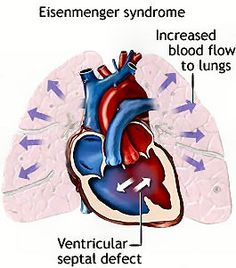Eisenmenger Syndrome Causes, Symptoms, Diagnosis and Treatment

What Is Eisenmenger Syndrome?
Eisenmenger’s syndrome is defined as the process in which a left to right shunt caused by a congenital heart defect in the fetal heart causes increased flow through the pulmonary vasculature, causing pulmonary hypertension, which in turn causes increased pressures in the right side of the heart and reversal of the shunt into a right-to-left shunt.
Causes Of Eisenmenger Syndrome:
Eisenmenger syndrome can be caused due to the following reasons:
- Born with a hole in the heart
- Atrioventricular canal defect
- Atrial septal defect
- Cyanotic heart disease
- Patent ductus arteriosus
- Truncus arteriosus
Symptoms Of Eisenmenger Syndrome:
Some symptoms may include:
- Bluish lips, fingers, toes, and skin (cyanosis)
- Chest pain
- Coughing up blood
- Dizziness
- Fainting
- Feeling tired
- Shortness of breath
- Stroke
- Swelling in the joints caused by too much uric acid (gout)
Diagnosis Of Eisenmenger Syndrome:
Doctors may diagnose Eisenmenger syndrome through the following tests and exams:
- Abnormal heart rhythm (arrhythmia)
- Enlarged ends of the fingers or toes (clubbing)
- Heart murmur (an extra sound when listening to the heart)
- Complete blood count (CBC)
- Chest x-ray
- MRI scan of the heart
- Putting a thin tube in an artery to view the heart and blood vessels and measure pressures (cardiac catheterization)
- Test of the electrical activity in the heart (electrocardiogram)
- Ultrasound of the heart (echocardiogram)
Treatment Of Eisenmenger Syndrome:
Different treatments for Eisenmenger syndrome are available. They include:
Medications:
- Medications to control arrhythmias
- Iron supplements
- Aspirin or other blood-thinning medications
- Endothelin receptor antagonists
- Sildenafil and tadalafil
- Antibiotics
- Blood drawing
If red blood cell count becomes too high, the doctor may recommend having blood drawn to help normalize the blood cell counts.
- Heart Lung transplantation
Some people who have Eisenmenger syndrome may eventually need a heart and lung transplant or a lung transplant with repair of the hole in the heart if no other treatments prove effective
By : Natural Health News




